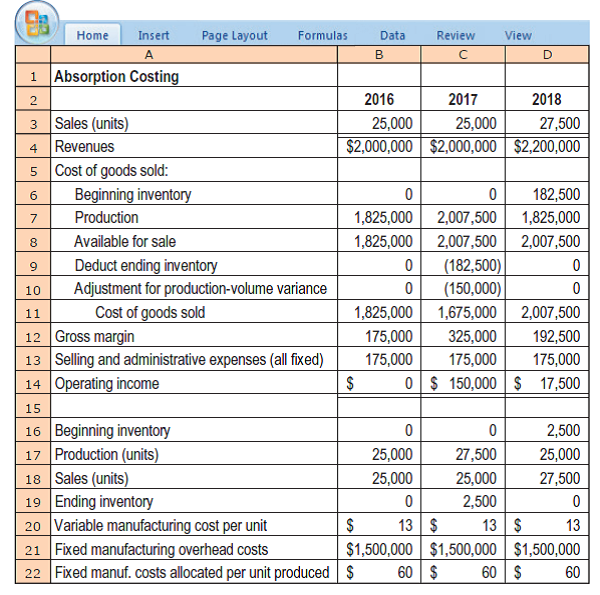Home Insert Page Layout Formulas Data Review View B 1 Absorption Costing 2016 2017 2018 3 Sales (units) 4 Revenues 5 Cost of goods sold: Beginning inventory 25,000 $2,000,000 $2,000,000 $2,200,000 25,000 27,500 182,500 Production 1,825,000 2,007,500 1,825,000 Available for sale 1,825,000 2,007,500 (182,500) (150,000) 1,675,000 2,007,500 2,007,500 Deduct ending inventory Adjustment for production-volume variance 10 Cost of goods sold 1,825,000 11 Gross margin Selling and administrative expenses (all fixed) Operating income 175,000 325,000 192,500 12 175,000 175,000 175,000 13 0$ 150,000 $ 17,500 14 15 16 Beginning inventory 17 Production (units) 2,500 25,000 25,000 27,500 25,000 18 Sales (units) 19 Ending inventory 20 Variable manufacturing cost per unit 21 Fixed manufacturing overhead costs 22 Fixed manuf. costs allocated per unit produced $ 25,000 27,500 2,500 13 $ $1,500,000 $1,500,000 $1,500,000 60 $ 13 $ 13 60 $ 60 Required 1. What denominator level is Candyland using to allocate fixed manufacturing costs to the candy? How is Candyland disposing of any favorable or unfavorable production-volume variance at the end of the year? Explain your answer briefly. 2. How did Candyland's accountants arrive at the breakeven volume of 25,000 units? 3. Prepare a variable costing-based income statement for each year. Explain the variation in variable costing operating income for each year based on contribution margin per unit and sales volume. 4. Reconcile the operating incomes under variable costing and absorption costing for each year, and use this information to explain to Jack McCay the positive operating income in 2017 and the drop in operating income in 2018.
Process Costing
Process costing is a sort of operation costing which is employed to determine the value of a product at each process or stage of producing process, applicable where goods produced from a series of continuous operations or procedure.
Job Costing
Job costing is adhesive costs of each and every job involved in the production processes. It is an accounting measure. It is a method which determines the cost of specific jobs, which are performed according to the consumer’s specifications. Job costing is possible only in businesses where the production is done as per the customer’s requirement. For example, some customers order to manufacture furniture as per their needs.
ABC Costing
Cost Accounting is a form of managerial accounting that helps the company in assessing the total variable cost so as to compute the cost of production. Cost accounting is generally used by the management so as to ensure better decision-making. In comparison to financial accounting, cost accounting has to follow a set standard ad can be used flexibly by the management as per their needs. The types of Cost Accounting include – Lean Accounting, Standard Costing, Marginal Costing and Activity Based Costing.
Variable and absorption costing, sales, and operating-income changes. Candyland uses


Trending now
This is a popular solution!
Step by step
Solved in 5 steps with 5 images


